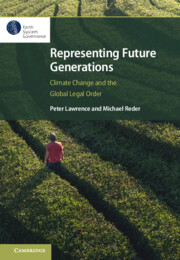Book contents
- Representing Future Generations
- Series page
- Representing Future Generations
- Copyright page
- Contents
- Preface
- 1 Introduction
- Part I Normative Framework
- Part II International Law and Institutions
- Part III Case Studies
- 6 The ICJ Advisory Opinion on Climate Change and Proxy Representation of Future Generations
- 7 A UN Committee on the Rights of the Child Case Study
- 8 A UN Special Envoy for Future Generations
- 9 Conclusion
- Index
- References
6 - The ICJ Advisory Opinion on Climate Change and Proxy Representation of Future Generations
from Part III - Case Studies
Published online by Cambridge University Press: 19 September 2025
- Representing Future Generations
- Series page
- Representing Future Generations
- Copyright page
- Contents
- Preface
- 1 Introduction
- Part I Normative Framework
- Part II International Law and Institutions
- Part III Case Studies
- 6 The ICJ Advisory Opinion on Climate Change and Proxy Representation of Future Generations
- 7 A UN Committee on the Rights of the Child Case Study
- 8 A UN Special Envoy for Future Generations
- 9 Conclusion
- Index
- References
Summary
Chapter 6 contains a case study in which we sketch how the normative framework set out in part A of the book, can be used as a basis for arguments that can be made in relation to the ongoing ICJ advisory opinion on climate change. It argues that the court should interpret international rules in a manner which furthers justice including intergenerational justice. This is essential for maintaining the court’s legitimacy, which must include its future legitimacy. The court should flesh out the principle of intergenerational equity by defining it in terms which require states to take climate action to ensure protection of the human rights of future generations necessary for them to lead a decent life. In addition, the normative framework is used to argue for: (i) an particular interpretation of the no harm rule to incorporate harm towards future generations and (ii) reform of the procedural rules of the ICJ so as to allow NGOs and scientists to make amicus curiae submissions (directly or implicitly) on behalf of future generations in proceedings before the court.
Keywords
Information
- Type
- Chapter
- Information
- Representing Future GenerationsClimate Change and the Global Legal Order, pp. 145 - 177Publisher: Cambridge University PressPrint publication year: 2025
